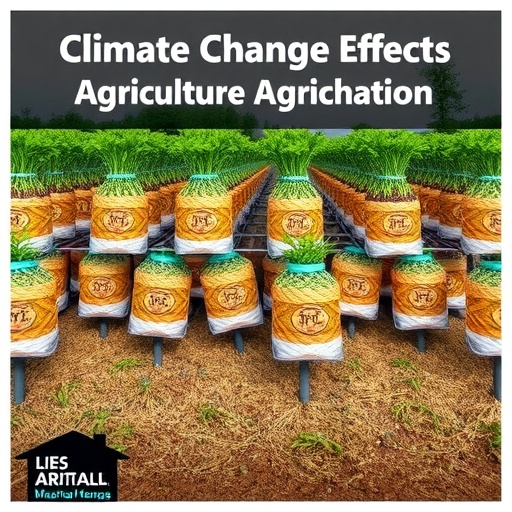
In a groundbreaking investigation into the interplay between climate change and global agriculture, recent research has for the first time quantitatively assessed how farmers around the world are adapting to shifting climatic conditions and applied these insights to future projections of agricultural productivity losses. This innovative econometric study illuminates the complex ways in which adaptation behaviors moderate the adverse effects of rising global temperatures on staple crop yields — a crucial advancement beyond traditional process-based models which often treat adaptation as a predetermined or external factor.
The findings reveal a statistically significant and substantial relationship between increases in global mean surface temperature (ΔGMST) and declines in the capacity of global food systems to produce calories, even after accounting for adaptation. This suggests that, although adaptive responses by producers mitigate some of the negative impacts of climate warming, these efforts are insufficient to fully counterbalance the expected declines in productivity. Without adaptation, the projections indicate even more severe consequences, underscoring the critical role that farmer decision-making plays in the resilience of global agriculture.
Notably, the distribution of climate-induced agricultural losses is highly uneven, disproportionately impacting low-income regions which are less able to absorb the economic shocks triggered by reduced crop yields and heightened food prices. Wealthier regions demonstrate a greater capacity to buffer these price fluctuations, suggesting that socio-economic factors mediate the severity of climate impacts on food security. This disparity highlights the urgency of integrating realistic representations of adaptive costs, imperfect information, and other behavioral nuances into future climate impact models to better forecast agricultural outcomes and inform policy.
.adsslot_GTH37e9LY1{width:728px !important;height:90px !important;}
@media(max-width:1199px){ .adsslot_GTH37e9LY1{width:468px !important;height:60px !important;}
}
@media(max-width:767px){ .adsslot_GTH37e9LY1{width:320px !important;height:50px !important;}
}
ADVERTISEMENT
One striking insight emerging from the data is the varying degree of adaptation observed across different global regions. Low-income, hotter climates exhibit more extensive producer adaptation, perhaps reflecting the more immediate and acute pressures these areas face. In contrast, wealthy regions with moderate climates—often referred to as global “breadbaskets”—show relatively limited adaptation currently. Given that these regions account for a substantial share of global agricultural production, their vulnerability potentially drives much of the projected global food security risk, emphasizing the strategic importance of enhancing adaptive measures in these locales.
The study also calls into question more optimistic projections derived from process-based crop models, many of which predict productivity gains under high-emission scenarios due to assumed “optimal” management practices. Ensemble results from initiatives like AgMIP forecast modest to significant increases in output for key crops such as maize, wheat, soybean, and rice by the end of the century. By contrast, the new analysis projects generally negative yield impacts, with declines ranging up to 35.6% for soybean. Critically, this econometric approach appears to outperform conventional models in simulating observed historical yield variations, suggesting a higher degree of reliability when empirical adaptation behaviors are explicitly factored in.
Despite these advances, it is important to acknowledge that the econometric framework does not offer mechanistic understanding of how climatic variables translate into physiological or agronomic changes within crops. Process-based models remain valuable for dissecting these mechanisms and for guiding targeted crop science innovations, especially within Genotype by Environment by Management (GxExM) frameworks, which seek to develop varieties resilient to heat stress and other climate-related challenges. Thus, the study underlines not only the magnitude of adaptation needed but also the complementary roles of empirical analysis and biological experimentation.
The trajectory of future adaptation could diverge substantially from historical patterns due to transformative technological breakthroughs that have historically reshaped agricultural productivity boundaries—for instance, the advent and spread of synthetic nitrogen fertilizers. Yet, the uneven global diffusion of such innovations and the stagnation in progress on heat tolerance for key staple crops temper expectations. This suggests that while ongoing innovation will continue to influence yield trends, adaptation to climate change presents immense challenges that exceed those addressed by past technological progress alone.
The magnitude of projected productivity losses underscores the critical need for accelerating agricultural innovation and expanding access to adaptive technologies worldwide. If such measures are insufficient or delayed, global food systems may face unprecedented instability, particularly in vulnerable regions where agricultural livelihoods are precarious. This finding frames adaptation not merely as a reactive process but as a vital frontier for scientific and policy intervention.
Monetizing the damages inflicted by climate change on agriculture, the authors provide a nuanced partial social cost of carbon (SCC) estimate that reflects observed adaptation. Their results contrast sharply with longstanding models such as the FUND framework, which historically produce negative SCC estimates for agriculture, implying warming benefits global agricultural welfare. Instead, this new study suggests a positive partial SCC ranging between $3.08 and $6.84 per ton of CO₂, revealing a more costly and concerning picture of climate impacts once adaptation is adequately considered.
This recalibration is further contextualized by comparison to meta-analyses based on process-based models, like those by Moore et al., whose estimates of agricultural damages are two to five times larger but do not incorporate observed adaptive behaviors. Incorporation of these empirical adaptation estimates into integrated assessment models remains an ongoing effort, with recent studies hinting at even larger climate damages when these social and economic dynamics are factored in—though further research is needed for accurate quantification.
Importantly, the current analysis is focused on staple crops and does not yet account for livestock or non-staple agricultural sectors, which constitute significant portions of the global food economy. The unequal effects of crop losses on the global poor—who may suffer particularly severe consequences from disrupted agricultural revenues and food supplies—also remain insufficiently captured in monetized damage estimates, signaling critical areas for extension in future research to foster more equitable policy frameworks.
The research highlights the limitations of current agricultural climate impact assessments and serves as a call to action for the global community. By bridging empirical adaptation data with rigorous econometric modeling, the study brings clarity to the uncertain terrain of climate-agriculture interactions. It opens new pathways for designing targeted interventions, from crop breeding to regional policy, aimed at safeguarding food security in an era of intensifying climate instability.
Looking ahead, the dynamic and multifaceted nature of adaptation suggests that continued monitoring and model refinement will be essential. Unraveling the socio-economic, technological, and environmental drivers that shape producer decision-making will enable more accurate projections and help identify leverage points for intervention. As climate change continues to challenge conventional agricultural paradigms, harnessing the resilience embedded in global farming communities may prove pivotal in averting the worst food security crises of the future.
This study thereby challenges prevailing narratives that climate change necessarily impedes agriculture uniformly or that adaptation is either wholly effective or negligible. Instead, it uncovers a nuanced landscape where adaptation plays a vital yet incomplete role, requiring intensified scientific innovation and inclusive policy mechanisms to ensure sustainable food systems for all.
Subject of Research: Impacts of climate change on global agriculture with consideration of producer adaptation.
Article Title: Impacts of climate change on global agriculture accounting for adaptation.
Article References:
Hultgren, A., Carleton, T., Delgado, M. et al. Impacts of climate change on global agriculture accounting for adaptation. Nature 642, 644–652 (2025). https://doi.org/10.1038/s41586-025-09085-w
Image Credits: AI Generated
DOI: https://doi.org/10.1038/s41586-025-09085-w
Tags: adaptation behaviors in global food systemsclimate change impacts on agricultureeconometric study on agriculture and climateeconomic shocks from climate-induced crop losseseffects of rising global temperatures on crop yieldsfarmers’ decision-making in climate resiliencefuture projections of global food securityglobal agricultural adaptation strategieslow-income regions and climate changemitigating negative impacts of climate warmingquantitative assessment of agricultural productivityuneven distribution of agricultural losses





